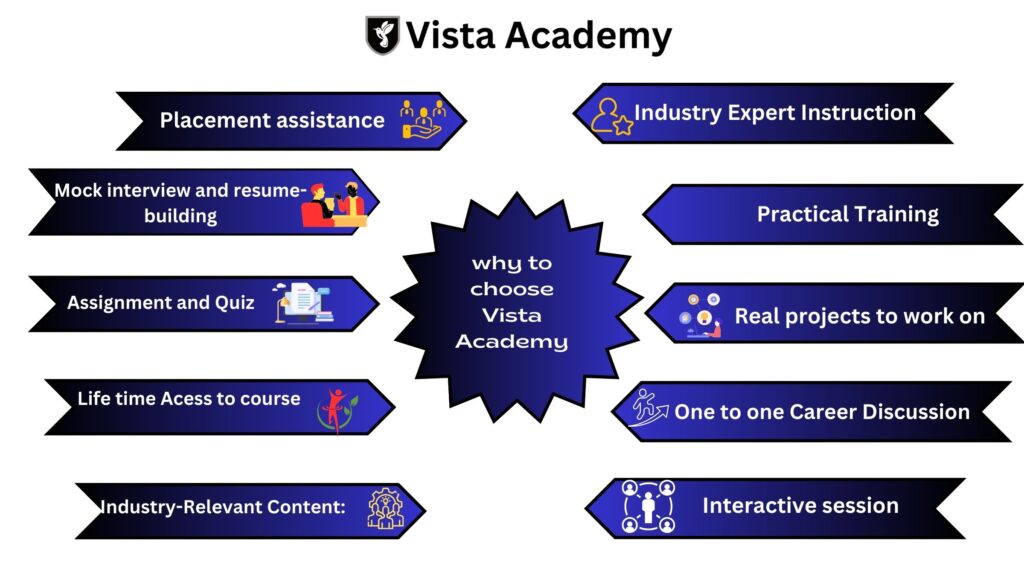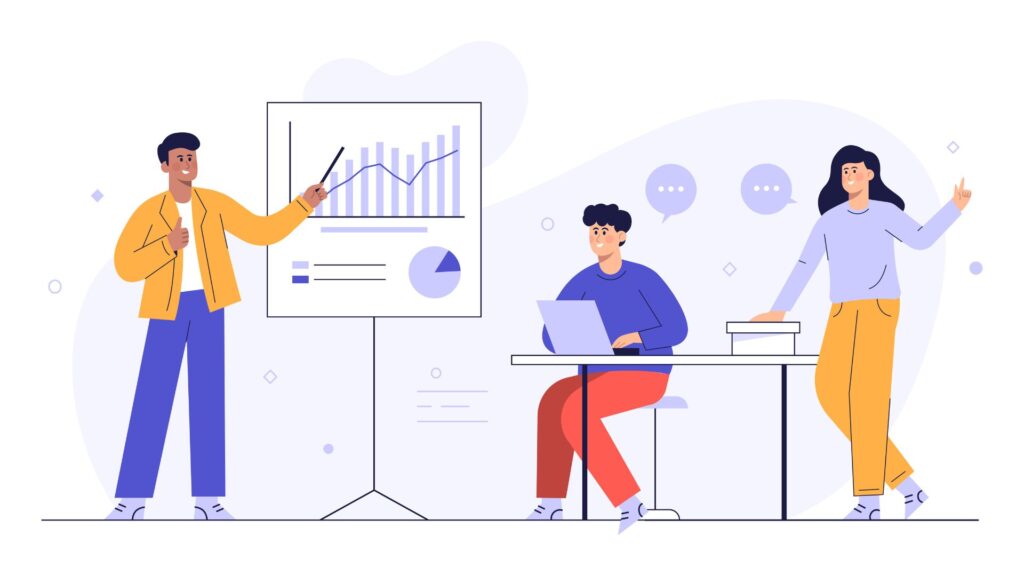Best Data Analytics Course in Dehradun
Table of Contents
ToggleUnlock the Power of Data Analytics with this Course!
Are you ready to take your career to the next level? With this data analytics course, you can unlock the power of data and equip yourself with the skills and knowledge to make informed decisions.
This comprehensive course is designed to provide you with the skills and confidence you need to work with data and make informed decisions. It includes a range of topics, including data analysis, predictive modeling, data visualization, and more.
By the end of this course, you will have the tools and skills you need to work with data, build models, uncover insights, and use data to inform your decisions.
Start your journey to becoming a data guru today! Enroll now and take advantage of our special introductory offer.
What is Data Analytics?
The act of analysing, cleansing, manipulating, and modelling data with the objective of identifying usable information, informing conclusions, and assisting decision-making is known as data analytics. Data analytics is utilised in a range of business, science, and social science sectors and encompasses a variety of techniques under many names. Data analytics helps firms make more scientific judgments and function more efficiently in today’s business world. Data analytics masters programming is the newest and most popular programming language in the business world today.
Data analytics is the study of breaking raw data into useful information to make decisions regarding that information.
Data Analytics Course
Data analytics courses are pursued by candidates aspiring to run a business in the future technologies. Data analytics courses assist to gain consumer insights from a large consumer database for helping businesses to make productive decisions.
Training program in Data Analytics
Vista Academy is a prime institute incorporate job training providing job training in Data Analytics Course With Excel, Tableau, SQL & Power BI and Python .
What are data analytics courses?
The Data Analytics program follows an applied learning model designed with real-life projects and business case studies.
In this Data Analyst certification course, you’ll learn analytical tools and technique, how to work with SQL database, the programming of R and Python, how to make data visualization and how to apply statistics and predictive analysis in the business environment.
Enroll in this training program and get Data Analytics certification
Data analytics is used in almost every sector of business
Retail:
Healthcare:
Manufacturing:
Using data analytics, the manufacturing sector can identify new cost-cutting opportunities. They are capable of resolving complex supply chain issues, labour shortages, and equipment breakdowns.
Banking sector:
Analytics are used by banks and financial institutions to identify potential loan defaulters and customer churn rates. It also aids in the immediate detection of fraudulent transactions.
Logistics
Logistics firms use data analytics to create new business models and optimise routes. This, in turn, ensures that the delivery arrives on time and at a low cost.
Data Analytics Applications
4. Efficient Operations
- Keeping track of and improving business performance. Every industry must evaluate their business performance on a regular basis.
Enhancing the Client Experience By examining data analytics in accounting, it is possible to improve client experience.
Risk Identification and Management A risk can come from a variety of sources both inside and outside of the company.
Increasing Profit Margins Data Analytics in Accounting can be used to uncover your employees’ behavioural patterns.
Banking Analytics is Improving the Financial Services Industry
Data Analytics as a Risk Management Strategy
Because the banking industry is built on risk, each loan and investment must be evaluated. BI tools can provide banks with new insights into their systems, transactions, customers, and environments, which can assist them in avoiding certain risks.
Marketing and sales automation
With today’s data volumes, banks can now gather previously unimaginable information about each of their customers. This gives them a better understanding of the needs of their customers and allows them to address these needs more proactively. It also enables various departments within a bank, such as marketing, sales, and information technology, to work more cohesively as a single unit.
Customer profitability
Business Analytics also provides banks with up-to-date information on their most profitable customers and their banking decisions. Banks can use that data to retain high-value customers, market the right products to them, and determine which products to invest in for the best return.
Performance analytics, budgeting and product innovation:
Banks can use analytics tools to measure business and employee performance, and then use that data to create branch budgets and employee goals based on past performance. Furthermore, they can schedule training and education for these employees during off-peak hours and track progress toward goals in real time. Banks can also use product, feature, and service performance data to develop new offerings based on current customer demand.

Is Data Analytics a viable career path?
Are data analyst paid well?
A data analyst with 1 – years of experience in India can earn up to Rs 3,96,128, while a mid-career Data Analyst with 5 – 9 years of experience can earn up to Rs 6,03,120 depending on the organisation and location of the working place.
Is it true that the government employs data analysts?
Government sectors are always looking for qualified candidates for data science jobs because they are one of the largest data collectors, from census data to national security intelligence.
Does data analyst have future in India?
According to NASSCOM, India’s Big Data industry will account for 32% of the global market, with a value of $16 billion by 2025, up from $2 billion today. Consistent use of Big Data is required to ensure the continued growth of Data Analytics in India. This will also open new doors of growth and opportunity in every sector.

Steps to Become a Data Analyst
Get your foundation
If you’re new to the topic of data analysis, you should begin by learning the basics of the subject. You may determine whether this career is a suitable fit for you by gaining a wide understanding of data analytics and developing job-ready abilities.
The majority of entry-level jobs for data analysts in the past required a bachelor’s degree. Although many jobs still require a degree, this is starting to change. With a degree in math, computer science, or a related topic, you can gain the fundamental information necessary and improve your CV, but there are other ways to acquire the skills you require, such as through professional certificate programs, boot camps, from Vista Academy Dehradun Uttarakhand.
Develop your Technical Skills.
Having a particular set of technical skills is often necessary to land a job in data analysis. These are some fundamental abilities you’ll probably need to get hired, whether you’re learning through a degree programme, professional credential, or on your own.
- Statistics
- Python Programming
- Structured Query Language, or SQL
- visualization of data with Power Bi
- Cleaning and preparing data power bi python
DATA ANALYTICS SKILLS TO LEARN IN 2023
New technologies and approaches will continue to be developed in the field of data analytics in 2023. Here are some crucial topics to concentrate on in order to keep current and improve your data analytics abilities:
Machine Learning
Develop your knowledge of machine learning algorithms, such as supervised and unsupervised learning, and their use in data analysis. Investigate well-known frameworks like TensorFlow, Scikit-Learn, and PyTorch.
Deep Learning:
Convolutional neural networks (CNNs), recurrent neural networks (RNNs), and other deep learning approaches, such as neural networks, should all be familiarised with. Learn how to use frameworks for deep learning like TensorFlow and Kera firsthand.
Natural Language Processing (NLP):
Learn how to handle and analyse data from human language. Learn about methods including sentiment analysis, language generation, named entity identification, and text categorization. NLP tasks can be aided by libraries like NLTK, spaCy, and transformers.
Big Data Technologies
Learn about big data processing technologies like Apache Spark and Hadoop. For managing massive volumes of data, be familiar with distributed computing ideas, data parallelism, and data streaming techniques.
Data Visualization
Enhance your skills in visualizing data effectively to communicate insights. Learn popular visualization libraries such as Matplotlib, Seaborn, and Plotly, and explore interactive visualization tools like Tableau and Power BI.
Data Warehousing
Learn about the concepts of data warehousing, such as data modelling, data integration, and ETL (Extract, Transform, Load) procedures. Learn about cloud-based data warehousing platforms like Amazon Redshift, Google BigQuery, or Snowflake.
Data Mining
Learn about the concepts of data warehousing, such as data modelling, data integration, and ETL (Extract, Transform, Load) procedures. Learn about cloud-based data warehousing platforms like Amazon Redshift, Google BigQuery, or Snowflake.
Data Governance and Ethics:
Recognise the ethical issues and legal implications associated to data analytics. Discover the best practises for ensuring data governance and responsible use of data, as well as information on data privacy, data protection laws (such as GDPR and CCPA), and related topics.
Data Storytelling:
enhance your presentation and communication abilities for data insights. Develop your ability to write appealing narratives, produce captivating data visualisations, and clearly explain findings to non-technical stakeholders.
Cloud Computing
Learn about the principles of and applications for cloud computing, including Amazon Web Services (AWS), Microsoft Azure, and Google Cloud Platform (GCP). Recognise the benefits of using cloud infrastructure for scalable and affordable data analytics.
Since data analytics is an area that is always changing, it is important to remain curious, continue learning, and adapt to new technologies and approaches as they become available. Keep up with market trends, take part in online learning opportunities, and join communities to advance your data analytics expertise in 2023 and beyond.
Course Detail
Week 1-2: Introduction to Data Analytics and Excel
Overview of data analytics and its applications
Introduction to Excel for data manipulation, analysis, and visualization
Week 3-4: Data Visualization with Excel and Power BI
Creating interactive dashboards and reports using Excel and Power BI
Data visualization best practices
Week 5-6: Data Analysis with SQL
Introduction to SQL for data retrieval and manipulation
Querying databases using SQL
Week 7-8: Introduction to Python for Data Analytics
Python basics for data manipulation and analysis
Working with libraries such as NumPy and Pandas
Week 9-10: Data Visualization with Python
Visualizing data using libraries like Matplotlib and Seaborn
Creating interactive plots with libraries like Plotly
Week 11-12: Data Analysis and Modeling with Python
Exploratory data analysis techniques
Introduction to statistical analysis and hypothesis testing with Python
Week 13-14: Advanced Excel for Data Analytics
Advanced Excel functions and formulas
Using Excel for data cleaning, transformation, and advanced analytics
Week 15-16: Advanced SQL for Data Analytics
Advanced SQL queries and joins
Database administration and optimization
Week 17-18: Advanced Python for Data Analytics
Advanced data manipulation techniques with Pandas
Machine learning libraries like Scikit-learn for predictive modeling
Week 19-20: Data Mining and Machine Learning Algorithms
- Introduction to common machine learning algorithms (e.g., linear regression, decision trees, clustering)
Applying machine learning algorithms using Python
Week 21-22: Data Wrangling and Preprocessing
Data cleaning, handling missing values, and outlier detection
Feature engineering and selection techniques
Week 23-24: Model Evaluation and Selection
Evaluating and validating machine learning models
Performance metrics and model selection techniques
Week 25-26: Model Deployment and Integration
Deploying machine learning models in production environments
Integrating models into applications or platforms
Week 27-28: Introduction to Big Data and SQL for Big Data Analytics
Overview of big data concepts and technologies
Working with SQL in big data environments (e.g., Hadoop, Spark)
Week 29-30: Data Visualization and Dashboarding with Power BI
Advanced data visualization techniques in Power BI
Creating interactive dashboards and reports
Week 31-32: Text Analytics and Natural Language Processing (NLP)
Introduction to text mining and NLP concepts
Analyzing and extracting insights from textual data
Week 33-34: Time Series Analysis and Forecasting
Analyzing and forecasting time series data
Time series models and techniques
Week 35-36: Advanced Machine Learning Techniques
Advanced machine learning algorithms (e.g., ensemble methods, deep learning)
Hyperparameter tuning and model optimization
Week 37-38: Data Ethics and Privacy
Understanding ethical considerations in data analytics
Privacy and data protection regulations
Week 39-40: Interview Skills and Resume Building
Effective communication and presentation skills for data analytics interviews
Crafting a compelling resume and cover letter
Week 41-48: Project Work and Capstone
Applying data analytics skills to real-world projects
Developing and presenting a data analytics project from start to finish
- Vista Academy offers a comprehensive Data Analytics program designed to equip you with the skills and knowledge needed to excel in the field.
- Our program is led by experienced instructors and industry experts who provide real-world insights and guidance.
- Dehradun’s serene environment offers a conducive learning atmosphere, free from the hustle and bustle of larger cities.
- Data analytics is a rapidly growing field with high demand for professionals in various industries such as finance, healthcare, marketing, and technology.
- Our program prepares you for roles like data analyst, data scientist, and business analyst, which are among the most sought-after positions in today’s job market
Our curriculum covers a wide range of topics, including data collection, data cleaning, data visualization, statistical analysis, and machine learning.
You’ll gain hands-on experience with industry-standard tools and programming languages like Python and R.
- A passion for working with data and a willingness to learn are the most important prerequisites.

